
 | "Hark to the Lassie and Ye'll find Y'r way!" |
 | "OK! Here are the clues for longtitude!
| 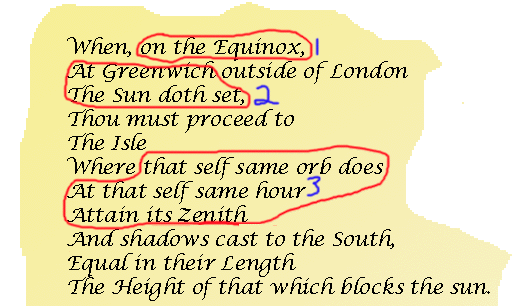 |
 | "Huh?!" |
 | "As I said, the first three clues are about time, Lou! They're going to help us with longitude!" |
 | "What does time have to do with location, Lulu?" |
 | "I'll show ya, Lou!" |
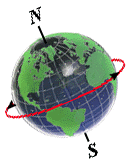 | "You know that the earth spins on its axis. And what do we call the length of time it takes to make one complete rotation? That is, Lou, to rotate 360 degrees?" |
 | "We call that one day - twenty four hours!" |
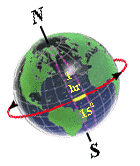 | "Exactly! So in one hour, the earth turns 1/24th of a complete rotation or 15 degrees! Now you remember longitude, Lou. Going right around the earth, from east to west for example, there are 360 degrees of longitude. So, here's another way of putting it: in one hour, the earth turns through 15 degrees of longitude! (That's the yellow arc between the two pink longitude lines that are 15° apart!)!" |  |
 | "Now, the actual time it is at any place on earth depends on the longitude of that place! Along the longitude of the shadow line, where day meets night and it's sunrise, it might be 6 AM. Each 15 degrees of longitude that you go towards the east, it's an hour later!" |  |
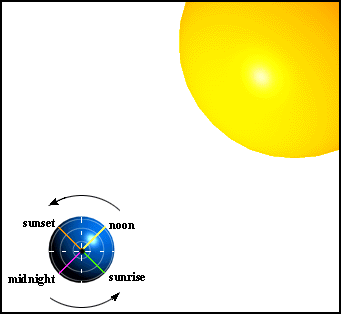 | "Here's a picture that shows what the earth would like to someone looking down at it from above the north pole. (The yellow globe that looks like part of a grapefruit is the sun!) Let's say that for people along the green longitude line it's six AM. For them, the sun is just rising above the horizon! For people along the yellow line it's noon! And for people along the orange longitude line, it's six PM and the sun is just setting!" "And as the earth rotates, the people along the sunrise longitude get carried around to the noon position, then to sunset, then midnight, and finally back to sunrise again during the 24 hours of the day!" |
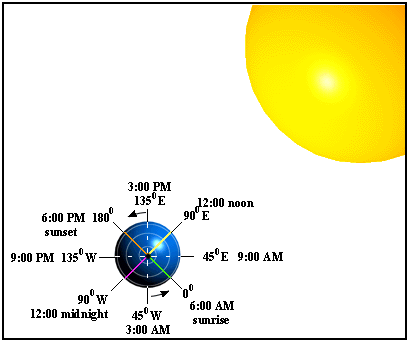 | "Here you can see the various times in more detail! So, for places separated by 15° of longitude, the local time is an hour different. An hour later as you go towards the east, an hour earlier as you go towards the west! And for places separated by 45° of longitude (the ones shown in the picture), the local times are three hours different!" |
 | "Now I see the connection between time and longitude! If you have two places at different longitudes, and you know the longitude and time at one of the places, you can figure out the longitude of the second place - if you know what the local time is there! For example, suppose I know the longitude at Louberg is 60° W, and it's 9 AM. Then I phone you at Luluville and you tell me it's 10 AM there. Then I know your longitude is 15° further east than mine. That means Luluville is at 45° W!" |  |
 | "But I have two questions! How do I know what the longitude of Louberg is? And how do we know what the time is in Louberg and in Luluville? How did we know how to set our clocks?" |
 | "Good questions, Lou! We'll deal with them together!" |
 | "OK! Imagine me spinning around on a merry-go-round! This is what you'd see! Me spinning against a stationary background!" |
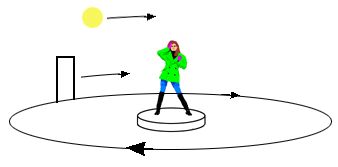 | "But to me, it'd appear as if I was stationary and everything else was spinning around me!" |
| "Now as we've said, Lou, the Earth spins on its axis - once every 24 hours! Here's a picture of the spinning earth with a sun that appears stationary! This what you'd see if you were in a rocket out in space! (You are the red dot in the rocket!)" |  |
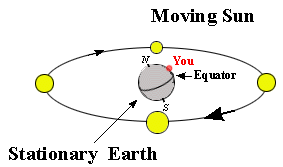 | "But if you were on earth, looking up at the sky, it would seem to you that the ground under you (the earth) was stationary and that it was the sun that was doing the moving!" |
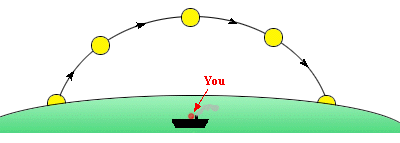 | "For example, imagine you were on a ship in the ocean (you're still the red dot). During the course of the day, from sunrise to sunset, the sun moves across the sky! As each hour passes, the position of the sun in the sky shifts! At noon, the sun is at its highest! In fact, 12 noon for any place is defined as the time when the sun is at the highest point in its daily path! That point is called its zenith! The zenith is when the daylight hours are half over!" |
| "All along the line of longitude that is facing directly towards the sun - the yellow line in the picture - the sun is its zenith! And all along that line, noon occurs at the same time!" | 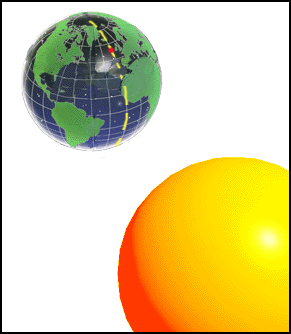 |
 | "So that's how we know how to set our clocks! When the sun is at its zenith for where we're located, we set our clocks to noon! And that happens at different times in different places, depending upon what your longitude is!" |
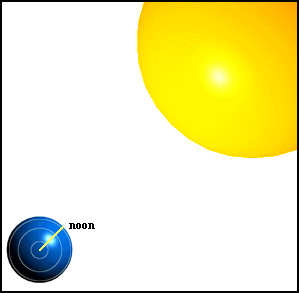 | "Right on, Lou boy! This picture shows the noon longitude line as it would appear to someone looking down at the earth from above the North Pole!" |
 | "For those folks along the green line, it won't be noon for another six hours! And for those folks along the orange line, noon won't occur again for another 18 hours!" |
 | "Cool! But how do you know when the sun is at its highest in the sky?" |
 | You can use an instrument known as a sextant! It measures angles between two objects, such as the horizon and the sun, very accurately. It can be used to determine when the sun is at its highest!" | 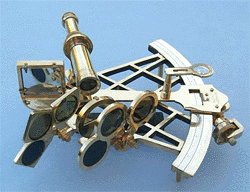 |
 | "All very enlightening! Now we know from the clue that at the Island the sun is at its zenith, so it's noon at the Island! But how do we know our longitude?!#&!" |
 | "Patience, Lou! You're almost there! It's very simple! Remember, if you know the time difference between two places, you know by how many degrees of longitude they are separated! For example, if it's 6:00 AM at one place and 9:00 AM at another, they are separated by 45° of longitude - 3 times 15." |  |
 | "OK, OK!" |
 | Now here's where Greenwich, England comes in! The longitude that pass through Greenwich is defined as 0° longitude! So if you know your time and the time in Greenwich, you know by how many degrees of longitude Louberg (where you are) is separated from 0°!" |
 | "But how do you know the time in London? I mean, suppose you're on a sailboat and you have no phone? And no radio?" |
 | That's where the chronometer comes in! A chronometer is a very accurate clock that is set to the local time at the Royal Astronomic Observatory at Greenwich, just outside of London! When you travel away from Greenwich, you take the chronometer with you. That way, no matter where you are, or what the local time is, you know the time at Greenwich!" | 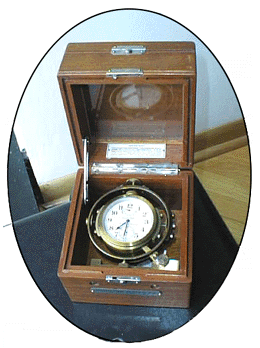 |
 | "Cool again! So now you know the time difference between where you are and Greenwich! But how does that give you your longitude?" |
 | "Well, suppose the time at Greenwich is 3 PM when its 12:00 hours (noon) where you are. The time difference is 3 hours. Each hour is equal to 15° of longitude. So the difference in longitude is 45°. Since the longitude of Greenwich is 0°, your longitude is 45° - 0° = 45°." |
 | "But is it east longitude or west longitude?" |
 | "If the time at Greenwich is later than noon, then you are to the west of Greenwich. If the time at Greenwich is before noon, then you are to the east of Greenwich!" |
 | "But what's all that about the equinox?" |
 | "Well, the clue doesn't tell us what the time is at Greenwich when it's noon at the Island! It just tells us that at Greenwich, the sun is setting! But the time at which the sun rises and sets changes throughout the year! So telling us it's sunset doesn't tell us enough! But at the equinox (the equinox occurs twice a year, on about September 21 and June 21) the length of the day is equal to the length of the night! Twelve hours each! So the sun rises and sets at six o'clock!" |
 | "Now we know what the time is at Greenwich when it's noon at the Island! Now we can figure out the longitude!" |  |
 | "You got it!!" |
 If ye think ye have the longitude now, check it out below!
If ye think ye have the longitude now, check it out below!
INSTRUCTIONS: Enter each answer in the appropriate box and then click the button to the right of it to find out if the answer is correct. Make sure not to enter letters or other symbols when numbers or numerical values are asked for. If letters are asked for, always enter them as capital letters.
 | "When ye ye've figured out the longitude, return to the treasure trail to chase the latitude!" |

2000
©David J. Leveson